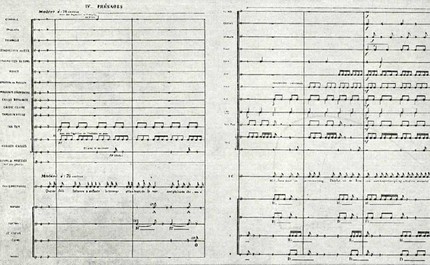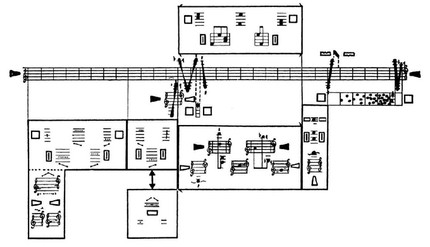
Musical letter |
musical notation, notation (Latin notatio, Italian notazione, semeiografia, French notation, semeiographie, German Notation, Notenschrift) is a system of graphic signs used to record music, as well as the recording of music itself. The beginnings of N. p. arose in ancient times.
Initially, the melodies transmitted by ear were designated pictographically. way (using images). In Dr. In Egypt, attempts were made to make such a record. In Dr. Babylon is believed to have used ideographic. (syllabic) recording of music. sounds using cuneiform writing (a clay tablet with cuneiform writing has been preserved – a poem was written with additional signs, which are interpreted as a syllabary notation of musical sounds). Track. the stage was the letter N. p. The letter system for designating sounds was used in Dr. Greece. Although this system recorded only the pitch of the sounds, but not their duration, it satisfied the musicians of that time, since the music of the ancient Greeks was monophonic and the melody was closely related to the poetic. text. Thanks to this, despite the imperfection of N. p., music and music. theory in Dr. Greece, along with other types of lawsuits, received a mean. development (see Alphabet musical, Ancient Greek music). By the 6th c. to designate sounds, along with Greek, the letters lat began to be used. alphabet; by the 10th c. way of designating sounds in Latin. letters completely replaced the former. The letter system in the 20th century. partially used in music-theoretical. liter-re to designate otd. sounds and tones. Dr. the ancient system was insane N. p., which became widespread in cf. century (see Nevmy). Special signs – neumes were written over the verbal text to remind melodies of chants; insane N. p. was used predominately. for Catholic notation. liturgical hymns. Over time, lines began to be used to more accurately indicate the height of the neum. Initially, such lines did not indicate the exact pitch of the sounds, but allowed the musician to see which of the number of sounds indicated by the neuma were relatively lower and which were relatively higher. The number of lines ranged from one to 18; systems from several lines, as it were, reproduced on paper the strings of muses. tool. In the 11th century Guido d’Arezzo improved this method of N. p., introducing four musical lines, which were the prototype of the modern. musical staff. At the beginning of the lines, he placed letter marks indicating the exact pitch of the sounds recorded on them; these signs were the prototypes of the modern. keys. Gradually, the non-meaning marks were replaced by square note heads, denoting only the pitch of the sounds. This N. p. was widely used to record Gregorian chant and therefore received the name choral (see Choral notation, Gregorian chant).
Track. a stage in the development of N. p. was the so-called. mensural notation, which fixed at the same time. and the pitch and duration of sounds. The latter was indicated by the shape of the note heads. The signs of the scale, which established the tripartite or two-part character of each note duration, were placed at the beginning of the musical line, and when the scale was changed, in the middle of the musical text. The signs of pauses used in this system corresponded to mensural durations and bore their names (see Mensural notation, Pause).
Simultaneously with mensural notation in the 15th-17th centuries. there was an alphabetic or numerical system, etc. tablature used to record instr. music. She had many varieties that corresponded to the characteristics of the department. tools; there were also national types of tablature: German, French, Italian, Spanish.
The method of designating chords with numbers written above or below a notated bass voice – general bass or basso continuo (continuous bass) was used with con. 16th century and has become widespread. he served as premier. for the presentation of the accompanying part of the organ and piano. In the 20th century digital bass is used only as an exercise in learning harmony.
The digital music recording system is used in modern. pedagogical practice to simplify learning to play on some bunks. tools. The stave is replaced by lines according to the number of strings of the instrument, numbers are written on them showing which fret in order the string should be pressed to the neck.
In Russia, a non-linear N. p. (znamenny, or hook) existed from the end. 11th c. (possibly earlier) to the 17th century. inclusive. It was a kind of deviant writing and was used in the Orthodox Church. singing. The notation of Znamenny singing was ideographic. form N. p. – signs denoted otd. intonations or motives, but did not indicate the exact pitch and extent of sounds. Later, additional signs were introduced that specified the height of sounds, the so-called. cinnabar marks (see Znamenny chant, Hooks).
In the beginning. 17th century in Ukraine, and then in Russia, with the notation of monophonic everyday chants, a gradual transition is made from hook writing to a 5-linear musical system using square notes and a cefaut key (see Key).
After centuries of searching in the process of development of the muses. the lawsuit was developed by modern. N. p., which, despite some shortcomings, continues to be used throughout the world to this day. The advantage of modern N. p. consists primarily in the visibility of the designation of the sound-altitude position of the notes and their metro-rhythm. ratios. In addition, the presence of keys that allow the use of a musical staff for recording dec. music ranges. scale, makes it possible to confine ourselves to a 5-linear musical system, only occasionally resorting to additional lines and complement. designations.

D. Millau. Les Choephores. 1916. Pages of the section score for reciter, choir of reciters and percussion instruments.
The constituent elements of modern. N. p. are: 5-line staff; keys that determine the height value of the lines of the stave; musical signs: oval heads with a stem (or stick) – unfilled (white) and filled (black); dec. elements of musical signs expressing relates. the duration of the sounds, based on the mathematical. the principle of division into two of each note (temporal) share; accidental signs at the key, fixing the height of a given step throughout the entire music. works, and accidentals with notes (random), changing the pitch only in a given measure and for a given octave; meter designations, i.e. the number of time beats in a measure and their longitude; add. signs prescribing an increase in the duration of a sound (dot, fermata, league), the union of several. musical staffs into a common musical system that meets the capabilities of the instrument, ensemble, choral and orchestral compositions (see Musical staff, Accolade, Key signs, Score).
Applied and developed system will complement. designations – tempo, dynamic, as well as indicating the involvement of certain methods of performance, the nature of expressiveness, etc. Along with the designations of the tempo, which allow, within a fairly wide range, decomp. implementation depending on the general musical and aesthetic. installations of the era and music. the feelings of the performer himself (designations such as allegro, andante, adagio, etc.), from the beginning. 19th century more and more often began to be used and complementary designations of the tempo, expressed in numbers of oscillations of the metronome pendulum. In connection with all this, N. p. began to record music more accurately. And yet this fixation never becomes as unambiguous as the fixation of music with the help of sound recordings.

K. Stockhausen. From the cycle for percussion.
Even with the most strict observance of the instructions of the composer, the performer can interpret the same musical notation of the muses in many ways. works. This record remains a stable written fixation of the work; however, in the real sound of music. works exist only in one or another performer. interpretations (see Musical performance, Interpretation).
New music. currents of the 20th century. brought with them some changes in the methods of musical notation. On the one hand, this is a further refinement and enrichment of performance designations, an expansion of their very complex. Thus, designations of conducting methods, designations of previously unknown types of performance (Sprechgesang), etc. began to be used. Designations appear that were put forward by this or that composer and were not used outside of his own work. In concrete music and electronic music, N. p. is not used at all – the author creates his own work. in a tape recording, which is the only one that does not allow k.-l. changes in the form of its fixation. On the other hand, adherents of muses. aleatorics in one or another of its varieties refuse the immutable written fixation of their works, leaving much in them at the discretion of the performer. Composers, who believe that the recreation of their ideas should be carried out in a form close to free improvisation, often carry out musical notation of their work. in the form of a series of “hints”, a kind of music. charts.
There is a special a system for fixing musical text for the blind, invented in 1839 by the French. teacher and musician L. Braille; used in the USSR in teaching music to the blind. See also Armenian music notation, Byzantine music.
References: Papadopulo-Keramevs K.I., The origin of musical notation among the northern and southern Slavs …, “Bulletin of Archeology and History”, 1906, no. 17, p. 134-171; Nuremberg M., Musical graphics, L., 1953; Riemann, H. Studien zur Geschichte der Notenschrift, Lpz., 1878; David E. Et Lussy M., Histoire de la notation musicale depuis ses origines, P., 1882; Wölf J., Handbuch der Notationskunde, Bd 1-1, Lpz., 2-1913; his, Die Tonschriften, Breslau, 19; Smits vanWaesberghe J., The musical notation of Guido d’Arezzo, “Musica Divina”, 1924, v. 1951; Georgiades Thr. G., Sprache, Musik, schriftliche Musikdarstellung, “AfMw”, 5, Jahrg. 1957, no 14; his own, Musik und Schrift, Münch., 4; Machabey A., Notations musicales non modales des XII-e et XIII-e sicle, P., 1962, 1957; Rarrish C., The notation of medieval music, L. – NY, (1959); Karkoschka E., Das Schriftbild der neuen Musik, Celle, (1957); Kaufmann W., Musical notations of the Orient, Bloomington, 1966 (Indiana University Series, No 1967); Ape60 W., Die Notation der polyphonen Musik, 1-900, Lpz., 1600.
V. A. Vakhromeev



